The isodecyl citrate market is estimated to be valued at USD 577.7 million in 2025. It is projected to reach USD 1,054.3 million by 2035, registering a compound annual growth rate (CAGR) of 6.2% over the forecast period.
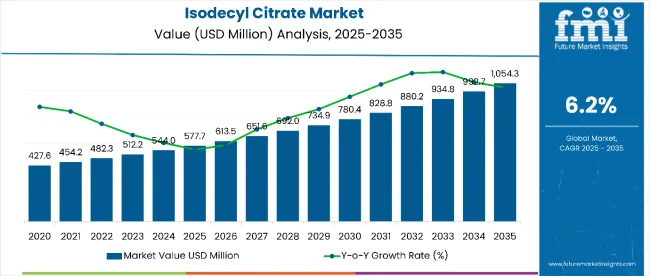
| Metric | Value |
|---|---|
| Estimated Size (2025E) | USD 577.7 million |
| Projected Value (2035F) | USD 1,054.3 million |
| CAGR (2025 to 2035) | 6.2% |
The market is projected to add an absolute dollar opportunity of USD 476.6 million over the forecast period. This reflects a 1.80-times growth at a compound annual growth rate of 6.2%. The market’s evolution is expected to be shaped by rising demand for biodegradable and skin-friendly ingredients across cosmetics, personal care, food emulsifiers, and pharmaceutical formulations.
By 2030, the market is likely to reach approximately USD 780.4 million, accounting for USD 202.7 million in incremental value over the first half of the decade. The remaining USD 273.9 million is expected during the second half, indicating a back-loaded growth pattern, as the compound effect accelerates in the later years.
Companies such as Vertellus Holdings LLC, Dien Inc., Independent Chemical Corporation, Univar Inc., ALZO International, and PNR Impex are reinforcing their competitive positions through investments in eco-friendly sourcing and scalable synthesis processes. Clean-label certification strategies are driving adoption in cosmetic and personal care formulations. Market performance is expected to remain anchored in regulatory compliance, eco-friendliness, and formulation efficacy benchmarks.
The market holds a niche but growing share within its broader parent markets. It accounts for approximately 1.0% of the global plasticizer market, reflecting its role as a safer, biodegradable alternative to traditional plasticizers. In the personal care ingredients market, isodecyl citrate represents about 0.8%, driven by increasing demand for skin-friendly and natural cosmetic additives. Within the food emulsifier market, it captures roughly 0.5%, primarily due to its multifunctional properties and clean-label appeal. Smaller yet strategic shares exist in the specialty chemicals, cosmetic ingredients, and pharmaceutical excipients markets, where regulatory compliance and environmental considerations are increasingly prioritized.
The market is being propelled by increasing consumer demand for clean-label and biodegradable ingredients, particularly in skincare and personal care formulations where transparent ingredient sourcing is a competitive advantage. Regulatory frameworks are prompting ingredient substitution away from phthalates toward safer alternatives like isodecyl citrate. Innovations are being advanced via formulation technologies that enhance skin feel and stability. E-commerce proliferation is enabling niche brands to incorporate isodecyl citrate in eco-friendly product offerings, accelerating adoption.
Isodecyl citrate’s biodegradable nature, skin-friendly profile, and multifunctional properties have positioned it as a preferred ingredient in cosmetics, personal care, and specialty chemical applications. Its ability to enhance product texture, stability, and sensory appeal is increasing its adoption among manufacturers seeking eco-friendly and high-performance formulation components.
Growing demand for clean-label and eco-friendly ingredients is driving uptake, particularly in skincare, haircare, and premium personal care products. Regulatory shifts encouraging the replacement of synthetic plasticizers with safer alternatives are further increasing its relevance.
As consumer awareness of environmentally responsible products rises and formulation innovation continues to evolve, isodecyl citrate is expected to achieve wider penetration across cosmetics, personal care, and specialty formulation markets. This momentum is being supported by advancements in green chemistry, supply chain transparency, and performance-oriented product development.
The market is segmented by type, application, distribution channel, and region. By type, the market is divided into natural, synthetic and organic. Based on application, the market is segmented into personal care products and beauty. In terms of distribution channel, the market is bifurcated into offline and online. Regionally, the market is classified into North America, Europe, Asia-Pacific, Latin America, Japan and the Middle East & Africa.
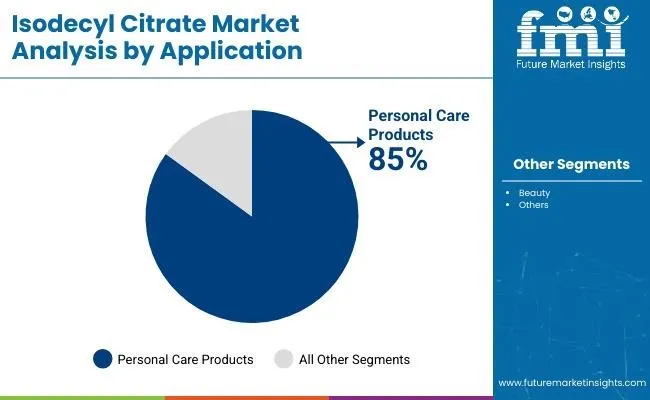
The personal care products segment holds a commanding 85% share within the application category, supported by increasing consumer preference for eco-friendly, skin-friendly, and multifunctional cosmetic ingredients. Isodecyl citrate’s emollient and stabilizing properties make it highly suitable for skincare creams, lotions, hair conditioners, and premium beauty formulations, where both performance and safety are critical.
Its role in enhancing product texture, improving spreadability, and delivering a smooth skin feel has encouraged widespread adoption by leading cosmetic brands. This segment has benefited from the surge in clean-label product demand, where synthetic additives are being replaced with biodegradable and dermatologically tested alternatives.
In addition, regulatory trends discouraging the use of phthalates and non-biodegradable agents have created additional opportunities for isodecyl citrate in high-end personal care lines. As consumer awareness of eco-friendly products intensifies and e-commerce platforms expand access to premium beauty products, this segment is expected to sustain strong growth over the forecast period.
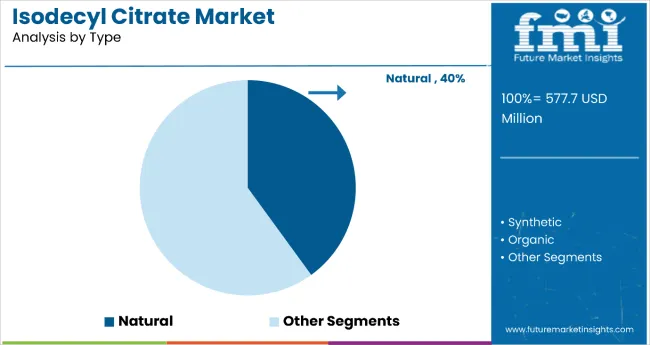
The natural type segment accounts for 40% of the market share in the type category, fueled by the global shift toward plant-derived and naturally sourced cosmetic ingredients. Formulated using bio-based feedstocks, natural isodecyl citrate appeals to both manufacturers and end consumers seeking eco-friendly, ethically produced, and high-purity raw materials.
Its low environmental impact and compliance with green-certification programs have accelerated its adoption in personal care and pharmaceutical formulations. In premium cosmetics, the natural variant is valued for maintaining consistent performance while aligning with environmental and ethical standards, making it an attractive choice for eco-conscious brands.
The segment’s momentum is reinforced by advances in green chemistry, which have improved production efficiency and reduced costs, thereby broadening accessibility. As global sustainability regulations become stricter and consumer trust in plant-based ingredients strengthens, the natural segment is positioned to capture a growing share of both established and emerging application areas.
The isodecyl citrate market has been expanding steadily due to growing demand for environmentally friendly and biodegradable plasticizers and cosmetic ingredients. Increasing consumer preference for clean-label, non-toxic, and skin-safe components in personal care products has driven widespread adoption. Applications in premium skincare, haircare, and specialty pharmaceuticals have been prioritized due to isodecyl citrate’s emollient properties and compatibility with natural formulations. Moreover, stringent environmental regulations limiting phthalate usage have compelled manufacturers to switch to safer alternatives, further accelerating market growth. Technological innovations in green chemistry and eco-conscious synthesis methods have enhanced the availability and cost-effectiveness of isodecyl citrate, supporting broader application development.
Sustainability and Regulatory Frameworks Drive Market Growth
Awareness regarding ecological impact and human health has propelled the adoption of plant-based and biodegradable plasticizers like isodecyl citrate. Regulatory frameworks across North America, Europe, and Asia-Pacific, such as REACH and EPA guidelines, are encouraging the phase-out of hazardous chemicals. Additionally, advancements in formulation science have improved product stability and skin compatibility, making isodecyl citrate an attractive option for formulators. E-commerce expansion has enabled niche and indie brands to access high-performance natural ingredients, increasing market penetration and innovation in personal care products.
Challenges in Production and Cost Constraints Limit Market Expansion
Despite promising growth, the isodecyl citrate market faces restraints linked to high raw material costs and complex production processes that require specialized equipment and regulatory compliance. Volatility in natural feedstock availability can lead to supply chain disruptions, impacting pricing stability. Furthermore, stringent quality and safety standards necessitate extended product development cycles and increased investment in certification, raising barriers for new entrants. Market adoption in price-sensitive regions remains limited, as alternatives with lower upfront costs are still preferred despite environmental concerns. Addressing these constraints through innovation and scaling production efficiency will be critical for sustained growth.
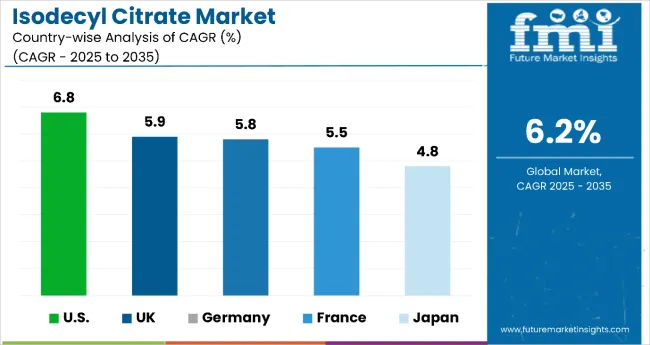
| Countries | CAGR (2025 to 2035) |
|---|---|
| United States | 6.8% |
| United Kingdom | 5.9% |
| Germany | 5.8% |
| France | 5.5% |
| Japan | 4.8% |
The isodecyl citrate market growth rates vary among the top five countries, with the USA leading at a CAGR of 6.8% from 2025 to 2035. The UK and Germany follow closely at 5.9% and 5.8% respectively, while France and Japan exhibit more moderate growth rates of 5.5% and 4.8%. These variations reflect differences in regulatory environments, consumer awareness of eco-friendly ingredients, and industry maturity. North America, driven by innovation and regulatory push, maintains a robust pace, whereas Europe’s growth is supported by stringent eco-friendly standards. Japan’s moderate growth is influenced by high-quality product demand and slower adoption of new formulations.
The report covers an in-depth analysis of 40+ countries; five top-performing OECD countries are highlighted below.
The demand for isodecyl citrate in the USA is anticipated to strengthen at a CAGR of 6.8% from 2025 to 2035, outpacing the global average. Growth is driven by strong demand in personal care formulations, emphasizing biodegradable and non-toxic ingredients. Major urban markets such as California, New York, and Texas lead adoption, supported by increasing consumer preference for clean-label cosmetics. Investments in green synthesis technologies and supply chain transparency are reinforcing market expansion. The USA regulatory framework encouraging phthalate replacements further accelerates isodecyl citrate adoption in cosmetic and specialty chemical industries.
Key Statistics
The isodecyl citrate market in the UK is expected to flourish at a CAGR of 5.9% from 2025 to 2035, slightly below the USA pace. Growth is focused on personal care products with eco-certified ingredients and premium formulations. London, Manchester, and Birmingham serve as innovation hubs, where brands emphasize sustainability and dermatological safety. Brexit-related supply adjustments have introduced some challenges but have also spurred domestic innovation. Regulatory support for phthalate alternatives strengthens the market outlook. Niche indie brands and online platforms are important drivers in increasing consumer awareness and demand.
Key Statistics
The revenue from isodecyl citrate in Germany is projected to rise at a CAGR of 5.8% from 2025 to 2035, supported by stringent EU regulations and consumer eco-consciousness. Frankfurt, Munich, and Hamburg are key regional centers of growth, where clean-label product development and functional cosmetic innovations thrive. German manufacturers prioritize high-purity and sustainability certifications, aligning with European chemical safety standards. Collaborative efforts between chemical producers and cosmetic formulators facilitate technology advancements. The market benefits from robust industrial infrastructure and growing demand for safe plasticizers in both personal care and specialty chemical applications.
Key Statistics
The sales of isodecyl citrate in France are estimated to expand at a CAGR of 5.5% from 2025 to 2035, slightly trailing Germany and the UK. Paris, Lyon, and Marseille are key markets emphasizing premium cosmetics and specialty personal care products. French consumer preference for natural and eco-friendly ingredients supports growth, alongside robust regulatory compliance with EU and national guidelines. Growth is propelled by artisan cosmetic brands and luxury product lines integrating biodegradable plasticizers like isodecyl citrate. The market remains influenced by evolving consumer trends toward health-conscious and eco-friendly beauty products.
Key Statistics
The isodecyl citrate market in Japan is projected to grow at a CAGR of 4.8% from 2025 to 2035, reflecting a more conservative but steady pace. Tokyo, Osaka, and Kyoto lead the demand for high-purity, dermatologically tested cosmetic ingredients. The market is driven by aging demographics and preference for hypoallergenic and skin-friendly formulations. While innovation in green chemistry is present, adoption of new biodegradable plasticizers is slower compared to Western markets due to stringent quality expectations and cautious consumer behavior. Nonetheless, demand for clean-label and natural products is gradually increasing, with e-commerce enabling broader product availability.
Key Statistics
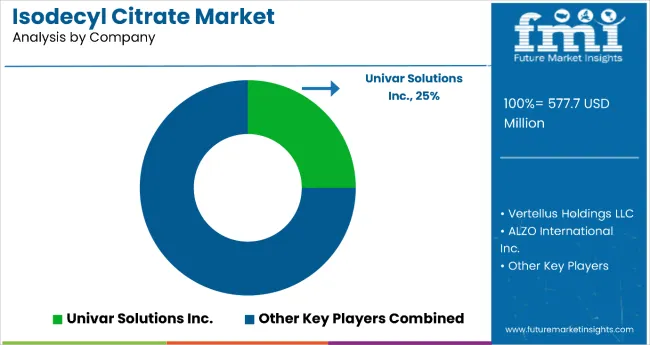
The isodecyl citrate market is moderately consolidated, comprising global chemical manufacturers, specialty ingredient producers, and regional suppliers with varied capabilities in eco-conscious synthesis and formulation expertise. Vertellus Holdings LLC and Dien Inc. are key international players, leveraging advanced green chemistry processes and extensive distribution networks to serve personal care, pharmaceutical, and specialty chemical industries. Their competitive advantage stems from scalable production capacities and strong regulatory compliance aligned with international environmental standards.
Mid-sized companies such as Independent Chemical Corporation and ALZO International differentiate through customized formulation support and specialty product lines focusing on natural and biodegradable plasticizers. These companies emphasize eco-certifications, product purity, and technical collaboration with cosmetic and pharmaceutical formulators, facilitating innovation in skin-friendly and multifunctional ingredients. Regional players, including PNR Impex and selected Asia-Pacific manufacturers, focus on cost-effective sourcing and localized supply chain solutions to penetrate emerging markets.
Barriers to entry remain substantial due to complex synthesis technology, feedstock sourcing challenges, and stringent regulatory frameworks governing ingredient safety and environmental impact. Competitive success increasingly depends on process innovation to reduce production costs, green chemistry certifications, and the ability to develop application-specific formulations that meet evolving consumer demands for sustainability and product performance. Strategic partnerships and investment in research and development are key drivers shaping the competitive landscape of the isodecyl citrate market.
| Item | Value |
|---|---|
| Quantitative Units | USD 577.7 Million |
| Type | Synthetic, Natural, Organic |
| Application | Personal Care Products, Beauty |
| Distribution Channel | Online and Offline |
| Regions Covered | North America, Europe, Asia-Pacific, Latin America, Middle East & Africa , Japan |
| Countries Covered | United States, Canada, United Kingdom, Germany, France, China, Japan, South Korea, Brazil, Australia and 40+ countries |
| Key Companies Profiled | Univar Inc., Vertellus Holdings LLC, ALZO International Inc., PNR Impex, Independent Chemical Corporation, Dien Inc. |
| Additional Attributes | Dollar sales by application and purity grade, regional demand trends, competitive landscape, consumer preferences for natural versus synthetic alternatives, integration with eco-friendly sourcing practices, innovations in extraction technology and quality standardization for diverse industrial applications |
The global isodecyl citrate market is estimated to be valued at USD 577.7 million in 2025.
The isodecyl citrate market size is projected to reach USD 1,054.3 million by 2035.
The isodecyl citrate market is expected to grow at a 6.2% CAGR between 2025 and 2035.
The natural type segment is projected to lead in the isodecyl citrate market with 40% market share in 2025.
In terms of application, the personal care products segment will command 85% share in the isodecyl citrate market in 2025.






Our Research Products

The "Full Research Suite" delivers actionable market intel, deep dives on markets or technologies, so clients act faster, cut risk, and unlock growth.

The Leaderboard benchmarks and ranks top vendors, classifying them as Established Leaders, Leading Challengers, or Disruptors & Challengers.

Locates where complements amplify value and substitutes erode it, forecasting net impact by horizon

We deliver granular, decision-grade intel: market sizing, 5-year forecasts, pricing, adoption, usage, revenue, and operational KPIs—plus competitor tracking, regulation, and value chains—across 60 countries broadly.

Spot the shifts before they hit your P&L. We track inflection points, adoption curves, pricing moves, and ecosystem plays to show where demand is heading, why it is changing, and what to do next across high-growth markets and disruptive tech

Real-time reads of user behavior. We track shifting priorities, perceptions of today’s and next-gen services, and provider experience, then pace how fast tech moves from trial to adoption, blending buyer, consumer, and channel inputs with social signals (#WhySwitch, #UX).

Partner with our analyst team to build a custom report designed around your business priorities. From analysing market trends to assessing competitors or crafting bespoke datasets, we tailor insights to your needs.
Supplier Intelligence
Discovery & Profiling
Capacity & Footprint
Performance & Risk
Compliance & Governance
Commercial Readiness
Who Supplies Whom
Scorecards & Shortlists
Playbooks & Docs
Category Intelligence
Definition & Scope
Demand & Use Cases
Cost Drivers
Market Structure
Supply Chain Map
Trade & Policy
Operating Norms
Deliverables
Buyer Intelligence
Account Basics
Spend & Scope
Procurement Model
Vendor Requirements
Terms & Policies
Entry Strategy
Pain Points & Triggers
Outputs
Pricing Analysis
Benchmarks
Trends
Should-Cost
Indexation
Landed Cost
Commercial Terms
Deliverables
Brand Analysis
Positioning & Value Prop
Share & Presence
Customer Evidence
Go-to-Market
Digital & Reputation
Compliance & Trust
KPIs & Gaps
Outputs
Full Research Suite comprises of:
Market outlook & trends analysis
Interviews & case studies
Strategic recommendations
Vendor profiles & capabilities analysis
5-year forecasts
8 regions and 60+ country-level data splits
Market segment data splits
12 months of continuous data updates
DELIVERED AS:
PDF EXCEL ONLINE
Citrate Market Growth – Trends, Applications & Forecast 2025 to 2035
Isocitrate Dehydrogenase (IDH) Inhibitors Industry Analysis by Type, Molecule Types, Route of Administration, and Region through 2035
Zinc Citrate Market Size and Share Forecast Outlook 2025 to 2035
Acid Citrate Dextrose Tube Market Trends – Growth & Industry Outlook 2024-2034
Sodium Citrate Dihydrate Market Growth - Product & Industry Trends
Calcium Citrate Malate Market
Potassium Citrate Market Growth - Trends & Forecast 2025 to 2035
Tricalcium Citrate Market Growth – Trends & Forecast 2025 to 2035
Triammonium Citrate Market Size and Share Forecast Outlook 2025 to 2035
Acetyl Tributyl Citrate market Size and Share Forecast Outlook 2025 to 2035
Food Grade Sodium Citrate Market
High Purity Magnesium Citrate Market Size and Share Forecast Outlook 2025 to 2035

Thank you!
You will receive an email from our Business Development Manager. Please be sure to check your SPAM/JUNK folder too.
Chat With
MaRIA